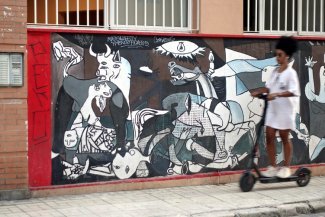Mil Duquelas, created by Estefanía Ruiz, is the first clothing brand to make Roma symbols, references and slogans its own. The T-shirts worn by the models bear the printed text “We are the granddaughters of the Gypsy women you were not able to kill,” in reference to the Roma and Sinti genocide, known as the Porrajmos, during the Second World War.
Paula was hired over the phone to work in a restaurant. Her first day went well. Despite the difficulty of the work, she did a good job. When she finished, the manager approached her and asked her an unexpected question: “Are you a Gypsy?”. She was never called back. The episode was denounced a few months ago in Madrid as a clear case of discrimination. Because if Paula had answered that question with a ‘no’ she probably would have kept her job. Because that question should never have been asked.
Rejecting a person simply because they are Roma, or look like they are, has a name: antigypsyism (also known as anti-Tsiganism or Romaphobia). It is a form of racism that – as defined in 2011 by the European Commission Against Racism and Intolerance – is specifically targeted at Roma people (an umbrella term, according to the European Network Against Racism, that emcompasses groups who share similar cultural characteristics, such as the Roma, Sinti, Travellers, Ashkali, Manush, Jenische, Kaldaresh and Kalé). In Europe, where they are now the largest ethnic minority with a total of around 10 to 12 million people, one in three Roma say they have experienced some form of harassment or discrimination in the last year alone.
Like all forms of racism, antigypsyism feeds on fears and prejudices based on supposed ‘racial superiority’ but, unlike the other forms, antigypsyism is still openly tolerated.
“If someone insults a Black person, it is understood to be racism, but a person who disrespects a Gypsy [editor’s note: in Spanish, the words ‘Gitano’ or ‘Gitana’ do not have the same pejorative connotations as the word ‘Gypsy’ can sometimes have in English] is not seen in the same way. In the social imaginary, unfortunately, there is always the same tagline: ‘they must have done something,’” Roma lawyer and activist Séfora Vargas tells Equal Times. And the data proves her right.
Today, 17 per cent of Europeans admit – according to the 2019 Eurobarometer – that they would feel uncomfortable if they had a Roma co-worker and 30 per cent say they would object if their son or daughter had a romantic relationship with a Roma person. The percentage of this prejudice far exceeds that of any other minority – more than people of different skin colour, sexual orientation, religion, age or disability. As Vargas says, antigypsyism is accepted, justified. “Society is used to seeing Roma in a negative light.”
Poverty, delinquency, conflict: the persecution of Roma has been built on the same stereotypes since the first families arrived from India seven centuries ago.
“It is structural racism,” explains social anthropologist David Lagunas, “based on the idea that Roma are a threat to others and even a threat to themselves. The idea is projected that their culture is deficient and so the problem lies with them.”
These are the same ideas that were behind the first anti-Roma laws in Europe, in the 17th and 18th centuries, the same ideas that fuelled the Roma and Sinti Holocaust – or Porrajmos (meaning ‘the devouring’ in Romani) – during the Second World War, which claimed the lives of at least half a million people, and the same ideas that, since the beginning of this century, have led to massive attacks on Roma communities in Austria, Hungary, the Czech Republic, Italy and Greece.Even fleeing the current war in Ukraine, Roma refugees are facing discrimination.
“The problem is not created by Roma culture, but by our perception of Roma people. It is our society that has these demons. So much so that even people who don’t consider themselves racist are racist when it comes to Gypsies,” says Lagunas. Even so, the anthropologist notes that “there is a group within the Roma population whose situation is even worse. They are the rejected of the rejected, because in addition to their status as Roma, they are also migrants. They are the Romanian Roma.”
They, more than anyone else, are burdened with the widely held belief that they have an “innate propensity to delinquency” which, as Lagunas explains in a recent research paper, does not correspond to reality either. “Such practices are only a last resort in a desperate situation, as is the case with any other vulnerable person in our society.”
A lack of trust leads to under-reporting
Anti-Roma racism ranges from direct attacks to everyday discrimination. For example, in Spain, a person who looks Romani is ten times more likely to be stopped by the police than a Caucasian-looking individual.
“It is so common that Roma people don’t even think about the fact that they are victims of a crime,” says Vargas.
In Spain, the Fundación Secretariado Gitano (the Gypsy Secretariat Foundation, or FSG) reports an average of 300 cases of antigypsyism every year. Roma men and women are denied employment, housing or even entry to leisure or entertainment venues because they are Roma, due to the perpetual presumption of criminality. But the most frequent manifestations are seen on social and mainstream media, in the form of anti-Roma attacks and discourse, which have been exacerbated during the pandemic. More than a few media and internet forums have linked the spread of the virus to the non-compliance of Roma people with health regulations.
The European Commission calls on states to investigate all these cases of antigypsyism as possible hate crimes, to establish specific laws for their prevention and to provide victims with easy access to justice, especially now that populist parties are once again using the Roma people as a scapegoat, as seen during the recent elections in Portugal.
Roma associations are trying to support this process. One example is the Federation of Roma Women’s Associations (Kamira), which has created a mobile phone application, Kamira SOS, to report cases of anti-Roma racism. “Through your mobile phone you can take photos, locate the place where the events occurred, see where the nearest police station is,” explains Carmen Santiago, its president. The application was launched by a women’s association because it is women who suffer most from this type of crime. “They suffer multiple forms of discrimination, based on their being women, gypsies and, in many cases, poor.”
It is, nonetheless, rarely reported – barely 10 per cent of all cases. “There is a lot of under-reporting,” confirms Mari Carmen Cortés, a spokesperson for the FSG. It has to do with a fear of reporting, mistrust of the police and civil servants, a lack of awareness about the channels to follow, but also low expectations. “There are very few positive rulings in the courts and this is a disincentive,” says Cortés.
“I myself reported a case of racism when I was studying at university and it was shelved,” says Vargas. “That’s why the penalties need to be strengthened and the offences need to be clearly defined. Otherwise, Roma people will continue to be easy targets.”
A cross-cutting wound
Stereotypes not only affect the current situation of the communities that must endure them but also their future. This can be seen in schools where, despite progress in schooling, 68 per cent of Roma pupils drop out before finishing secondary school and only 18 per cent go on to higher education. And this has always been blamed on the families, on the culture.
“It is widely believed that Roma don’t want to go to school, that we don’t want to integrate, but these are statements that we would never make about other social groups,” denounces Fernando Macías, professor at the University of Barcelona and founder of Campus Rom, the first Roma university network in Spain. “The family obviously has a role to play, but research has shown that success does not depend on the culture of the people, but on the type of educational practices.”
One such practice that is still in place today, despite being clearly discriminatory, is the segregation of Roma pupils in different schools and classes.
Around 46 per cent of Roma children in Europe are concentrated in the same schools and institutes, which Macías argues, is also antigypsyism.
Education for Roma children has improved, but not enough. Nor have plans to facilitate access to employment, health care or housing for their parents. Still today, 80 per cent of Roma in Europe live at risk of poverty, and the reason – as the European Commission itself has acknowledged – is that the cross-cutting problem of discrimination has not yet been tackled. The excessively paternalistic policies that have been implemented since 2011 have forgotten the most important thing: combating racism.
In February 2022, Spain took a step forward in the fight against anti-Roma racism. It incorporated the history of the Roma people into secondary school textbooks. The idea is to teach young people about past episodes of persecution and the keys to their culture, their symbols, their language and their contribution.
“It is a great achievement,” says Cortés. “We have to start talking about the history of the Roma people as a real and shared history.”
It has taken them years to achieve just that: “visibility”, something that has yet to be achieved in other areas such as popular culture.
This is what activist Vicente Rodríguez is arguing. Passionate about comics since he was a small child, at the age of seven, he discovered “that Magneto, an antagonist of the X-Men, was a gypsy and a Holocaust survivor”. Since then, pop culture is the area he has been moving in to help break with anti-Roma discourse.
He stirred a great deal of interest during the 2016 Comic Con, in New York, when he asked a group of cartoonists “why the Roma community wasn’t better represented in comics”.
“We are calling for the inclusion of more Roma authors and Roma characters, as are other minorities, but, above all, for guideline recommendations so that we are not always depicted as thieves or witches,” he tells Equal Times.
Representation is important, as movements such as Black Lives Matter, LGBTI Pride and #MeToo know. Estefanía Ruiz also knew it when, tired of designing T-shirts with logos for others, she decided to create Mil Duquelas the first clothing brand that has made Roma symbols, references and slogans its own.
“I imagined what it would have been like if, throughout my life, there had been a brand that reflected everything that’s part of my identity. I imagined girls wearing a Papusza – the first Gypsy poet – T-shirt to go to school without any kind of fear,” says the designer. “The brand seeks to put teyan end to the silence that surrounds our people. We give people the chance to wear clothes that reflect the fact that we are proud to be Roma.”
Attempts to dismantle one of the most enduring forms of racism are now being built on the words of these young men and women – 60 per cent of the Roma community is under 30 years old, and they are ready to claim their roots. But they oth must still face all of those empty stereotypes that forced them to be judged, condemned and discriminated against more than any other demographic in Europe.













